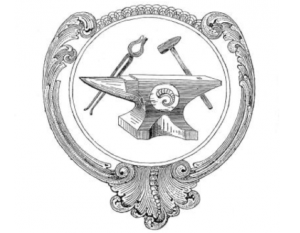This is the second installment of master blacksmith Cyril Colnik’s liturgical ironwork from my archives. Unfortunately, these images have no indication on them as to where these pieces were installed. The image above shows several fine pieces; candlesticks, a prie-dieu (prayer kneeler), *, and what appears to be an eternal
“Reproduction Chandelier” , 2004, mild steel, black Gilders paste finish Two of the installations in this blog have dealt with repoussé elements applied to a reproduction of a Cyril Colnik chandelier, made for the “Captain Frederick Pabst Mansion” back in 2004. (See above image.) In this installment, I would like
“Candlestick 2005.” 6 1/2″ x 12″, mild steel, black Gilders Paste finish. Photo by George Lottermoser. There are different processes of repoussé, as explained in an earlier discussion here. Today we will take a closer look at the process of sinking. The below-story board shows the development of a bobeche,
Cyril Colnik (1871-1958) was born in Triebein, Austria on September 20th, 1871. He traveled Europe as a journeyman, and later enrolled in to the Munich Indiustrial Art School. Germany adopted him, and sent him to help with their ironwork exhibit at the 1893 World’s Columbian Exhibition in Chicago. It is
After forging decorative and architectural ironwork for over 30 years, there seems to be no end to design possibilities in sight. The thrill of discovery, of new forms, of yet untried motifs, has me returning to the drawing board, and consequently to the fire with anticipation. This is the stuff
French repoussé, also called “hammer and stake raising”, is one of several repoussé processes. This method utilizes several small raising hammers, that lightly strike the sheet metal over various stake forms held in a vise. Another process involves “sinking”, by using various punch-like forms to force the sheet metal into
Blacksmith Francis Whitaker, (1906 -1999) was in Germany for two years working for Master Blacksmith Julius Schramm. Schramm (1870 – 1945) asked a young Francis how he was to address a specific problem on a stand to hold a large bowl. Francis replied to the master that he would simply
Designing decorative and architectural ironwork often has its frustrating moments…..hours……days. The design for this garden gate in Cedarburg needed to address the wonderful stonework, the bursts of foliage and color in the gardens, and the starkness of the winter months. Before the pencil proceeds to sketch ideas, a trip to
This is a sign bracket that I restored for a client several years ago. The workmanship is reminiscent of German ironwork during the Renaissance. After removing the many years of paint, it is always interesting to see the various tool marks, forge welds, and in this case, all the brazed
Master Blacksmith Samuel Yellin (1885-1940) of Galicia, Poland, came to America in 1906. Probably the best known of the European born master blacksmiths in America, Yellin set up shop in Philadelphia in 1909. His last shop was located on Arch Street. Yellin was a prolific businessman. His shop boasted over
